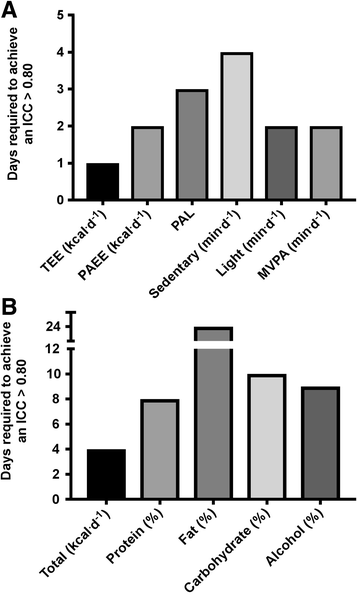Energy balance components in persons with paraplegia: daily variation and appropriate measurement duration
- PMID: 28950900
- PMCID: PMC5615439
- DOI: 10.1186/s12966-017-0590-z
Energy balance components in persons with paraplegia: daily variation and appropriate measurement duration
Abstract
Background: Despite obesity being highly prevalent in persons with spinal cord injury (SCI), our current understanding of the interactions between energy balance components, which may contribute to this, is limited. The primary aim of this study is to identify the intra-individual variability of physical activity dimensions across days and suggest an appropriate monitoring time frame for these constructs in adults with SCI. The secondary aim is to examine these parameters with regard to energy intake and dietary macronutrient composition.
Methods: Participants [33 men and women with chronic (> 1 year post injury) paraplegia; age = 44 ± 9 years (mean ± S.D.] wore an Actiheart™ PA monitor and completed a weighed food diary for 7 consecutive days. Spearman-Brown Prophecy Formulae, based on Intraclass Correlations of .80 (acceptable reliability), were used to predict the number of days required to measure energy balance components. Linear mixed-effects analyses and magnitude-based inferences were performed for all energy intake, expenditure and physical activity dimensions. Adjustments were made for age, injury level, wear time, sex, day of the week and measurement order as fixed effects.
Results: To reliably measure energy expenditure components; 1 day [total energy expenditure (TEE)], 2 days [physical activity energy expenditure (PAEE), light-intensity activity, moderate-to-vigorous PA (MVPA)], 3 days [physical activity level (PAL)] and 4 days (sedentary behaviour) are necessary. Device wear time (P < 0.02), injury level (P < 0.04) and sex (P < 0.001) were covariates for energy expenditure components. Four and ≤24 days are required to reliably measure total energy intake (kcal) and diet macronutrient composition (%), respectively. Measurement order (from day 1-7) was a covariate for total energy intake (P = 0.01).
Conclusions: This is the first study to demonstrate the variability of energy intake and expenditure components in free-living persons with chronic (> 1 year) paraplegia and propose suitable measurement durations to achieve acceptable reliability in outcome measures. Device wear time and measurement order play a role in the quality of energy expenditure and intake data, respectively, and should be considered when designing and analysing studies of energy balance components in persons with SCI.
Trial registration: N/A.
Keywords: Assessment; Diet; Energy balance; Energy expenditure; Energy intake; Intra-individual variance; Measurement; Paraplegia; Physical activty; Spinal cord injury.
Conflict of interest statement
Authors’ information
N/A
Ethics approval and consent to participate
The data presented in this study was collected as part of two independent studies, with ethical approval granted by the University of Bath’s Research Ethics Approval Committee for Health (REACH) and the South West (Exeter) National Research Ethics Service Committee (REC reference number 14/SW/0106). All participants provided signed and informed consent.
Consent for publication
Not applicable.
Competing interests
The authors declare that they have no competing interests.
Publisher’s Note
Springer Nature remains neutral with regard to jurisdictional claims in published maps and institutional affiliations.
Figures


Similar articles
-
Caloric Intake Relative to Total Daily Energy Expenditure Using a Spinal Cord Injury-Specific Correction Factor: An Analysis by Level of Injury.Am J Phys Med Rehabil. 2019 Nov;98(11):947-952. doi: 10.1097/PHM.0000000000001166. Am J Phys Med Rehabil. 2019. PMID: 30817378 Free PMC article.
-
Relationship of high energy expenditure and variation in dietary intake with reporting accuracy on 7 day food records and diet histories in a group of healthy adult volunteers.Eur J Clin Nutr. 2002 Apr;56(4):358-67. doi: 10.1038/sj.ejcn.1601341. Eur J Clin Nutr. 2002. PMID: 11965513
-
Frequency of Dietary Recalls, Nutritional Assessment, and Body Composition Assessment in Men With Chronic Spinal Cord Injury.Arch Phys Med Rehabil. 2015 Sep;96(9):1646-53. doi: 10.1016/j.apmr.2015.05.013. Epub 2015 Jun 3. Arch Phys Med Rehabil. 2015. PMID: 26047531
-
Energy expenditure in chronic spinal cord injury.Curr Opin Clin Nutr Metab Care. 2004 Nov;7(6):635-9. doi: 10.1097/00075197-200411000-00008. Curr Opin Clin Nutr Metab Care. 2004. PMID: 15534431 Review.
-
Energy expenditure and requirements in aging humans.J Nutr. 1992 Nov;122(11):2057-65. doi: 10.1093/jn/122.11.2057. J Nutr. 1992. PMID: 1432248 Review.
Cited by
-
Virtual Strategies for the Broad Delivery of High Intensity Exercise in Persons With Spinal Cord Injury: Ongoing Studies and Considerations for Implementation.Front Sports Act Living. 2021 Aug 6;3:703816. doi: 10.3389/fspor.2021.703816. eCollection 2021. Front Sports Act Living. 2021. PMID: 34423292 Free PMC article. Review.
-
Nutrition Education to Reduce Metabolic Dysfunction for Spinal Cord Injury: A Module-Based Nutrition Education Guide for Healthcare Providers and Consumers.J Pers Med. 2022 Dec 7;12(12):2029. doi: 10.3390/jpm12122029. J Pers Med. 2022. PMID: 36556250 Free PMC article. Review.
-
Nutritional status in chronic spinal cord injury: a systematic review and meta-analysis.Spinal Cord. 2019 Jan;57(1):3-17. doi: 10.1038/s41393-018-0218-4. Epub 2018 Nov 12. Spinal Cord. 2019. PMID: 30420688
-
The comparison of total energy and protein intake relative to estimated requirements in chronic spinal cord injury.Br J Nutr. 2024 Feb 14;131(3):489-499. doi: 10.1017/S0007114523002088. Epub 2023 Sep 20. Br J Nutr. 2024. PMID: 37726106 Free PMC article.
-
Accuracy of the Apple Watch Series 4 and Fitbit Versa for Assessing Energy Expenditure and Heart Rate of Wheelchair Users During Treadmill Wheelchair Propulsion: Cross-sectional Study.JMIR Form Res. 2024 May 7;8:e52312. doi: 10.2196/52312. JMIR Form Res. 2024. PMID: 38713497 Free PMC article.
References
MeSH terms
LinkOut - more resources
Full Text Sources
Other Literature Sources
Medical

